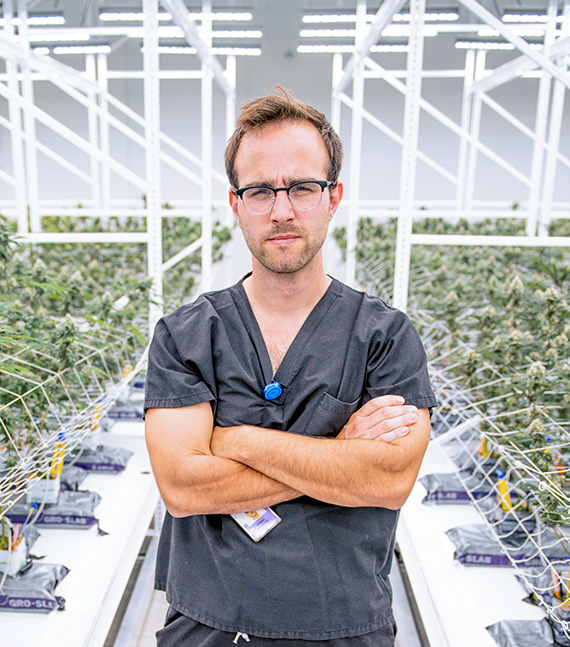More and more countries are relying on the medical effects of cannabis. The exact ingredients are due to the right light.<strong><span> </span></strong>
The scene: a brightly lit hall near Cleveland, Ohio. There are thousands of tender seedlings with their characteristic serrated leaves lined up in high bays, as well as mature cannabis plants in full bloom standing almost head high. Founded in 2016, “Buckeye Relief” is devoted entirely to the cultivation of medicinal cannabis.
A blossoming business
Buckeye stands for a development that has taken North America by storm following the legalization of cannabis in Canada and many US states. Long prohibited, research into and cultivation of the cannabis plant are experiencing a real boom right now. Around 200,000 full-time employees in the US already work in this industry. By way of comparison, this corresponds roughly to the number of all taxi drivers and chauffeurs in the country.
Yet, the medical effects of the cannabis blossoms have been known for a long time. “The Chinese were using cannabis thousands of years ago as a basis for medicines”, said Jeremy Shechter, Cultivation Technology Director at Buckeye.“ Today, more and more doctors and scientists recognize the tremendous medical potential of the plant.” Cannabidiol (CBD), one of the primary active cannabinoid in medicinal cannabis, reduces convulsions and anxiety and relieves pain – for example for cancer patients. Tetrahydrocannabinol (THC), another cannabinoid, also has therapeutic properties. Above a certain concentration, however, it is psychoactive and produces a “high.”
But those are just the most prominent active substances of the plant. There are many other cannabinoids as well as terpenes. “At present, there are more than 600 known cannabis species. Each plant produces hundreds of active substances in different compositions and concentrations. Enriching and combining these agents is the key to treating a very wide range of illnesses”, added Jeremy.
Active control
And light plays the crucial role in this. It influences the concentration and composition of the active substances in the plant. “Plants require a dynamic environment for optimum growth and development”, said Jeremy. Different types of lighting fixtures and lighting scenarios are therefore employed depending on the particular growth phase. “We observe the different growth characteristics in conjunction with the CO2 uptake of the plant. In doing so, we also gain an insight into how the plants process the light.”

For this he relies on lighting technology and know-how from OSRAM’s US subsidiary Fluence Bioengineering. Fluence is the leading LED provider of cannabis horticultural lighting solutions in North America. For cultivating medicinal cannabis in particular, it offers its customers a wealth of experience and a sophisticated portfolio of specialized LED lighting technology. “Our full-spectrum lights offer customers energy savings up to 40 percent compared to traditional discharge lamps. What’s more, their variable wavelengths enable plant growth and the proportions of the active ingredients to be reliably controlled,” said Fluence manager Timo Bongartz. And demand is growing: the company is currently expanding from Texas to Europe and Asia.
Plant and data quality
Quality lighting is essential for Buckeye. After all, cultivation of cannabis for medicinal purposes is subject to strict legal requirements governing pharmaceuticals. “To ensure the products are of consistent high quality we constantly research, monitor and optimize the environmental conditions,” said Jeremy. “We have our own quality control labs. Each batch must be tested and certified by the state.” This guarantees consistent pharmaceutical quality for the patient.
“At the moment we are collecting as much data as we can. About growth, about the harvest, and about the proportion of cannabinoids,” he adds. Buckeye started with 100 varieties of cannabis and 10,000 plants. Each with its own genetic characteristics. “We are currently filtering out the successful plants. We now have about 150 phenotypes and 38 varieties. And we want to narrow this down further.”

In a new light
But what about the unseemly image that attaches itself to the cultivation of cannabis, namely the recreational use of marijuana? “There is now a lot less stigma than there was a few years ago,” said Jeremy. “Medical successes have made people curious. My wife’s grandfather suffered from pancreatic cancer. Medicinal cannabis helped him with his pain. Many people have witnessed the therapeutic properties of cannabis among family and friends. That puts the cultivation of cannabis in a new light.”
The therapeutic effects on a cancer patient in the family is a motivating force for Timo Bongartz as well. He is therefore critical of the ban on research into cannabis that is still in force in many parts of the world. “I am delighted whenever we contribute to research and product improvements with our lighting technologies. Researchers are discovering the incredible potential of this plant for treating diseases – whether that’s cancer, Parkinson’s or multiple sclerosis. And I am convinced that we will see many more medical applications in the coming years.”